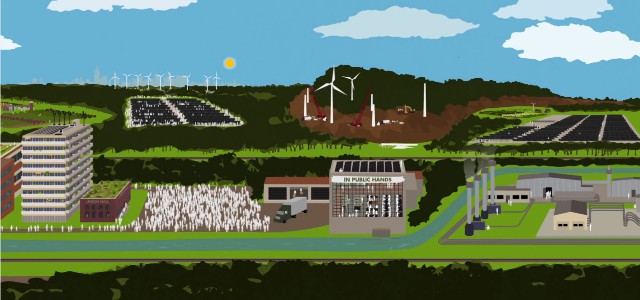One of Germany’s political foundations, the Rosa Luxemburg Foundation, has produced a video in English explaining the term “energy democracy” to North Americans. It was made in cooperation with labor unions and thus focuses on job creation. Craig Morris likes the presentation but fears some main points might not be highlighted enough.

The future of energy could be democratic. (Screenshot of the video under fair use)
The concept of energy democracy certainly deserves more attention outside Germany. Within Germany, the concept is fairly well understood. There is a reason why German utility companies like Eon and RWE have mainly invested in wind power, for instance, in the UK and not at home. In Germany, any such investments would compete with their own stranded conventional energy assets. In the UK, however, these new wind farms offset the conventional energy production of their competitors. In Germany, therefore, the market needed entirely new players for the energy transition. The new players in Germany not only include startups, but citizens themselves.
In the US, the public seems quite content to have their utilities handle the energy transition for them. Obviously, an argument can be made that the environment and climate do not care who makes the energy transition investments. Yet the transition to renewables will at least partly entail greater distributed energy production from small systems that no longer necessarily have to belong to large utility companies. As the video from the Rosa Luxemburg Foundation argues, if profit motives are taken out of the foreground, then energy supply as a public service could increasingly be seen as a public good – a point also made by the German Energiewende book from 1985.
The Rosa Luxemburg Foundation is the think tank of Germany’s Left Party (Die Linke). Over the past few years, the Foundation has been working with labour unions in the US. This year, they have produced a new video entitled “This is what energy democracy looks like.” Generally, the presentation is good, but you have to skip to around minute 3:00 before you get to the real story– and that is my main point of criticism. Indeed, the video generally makes the same argument I often do, only that I speak of citizens, not workers.
[youtube width=”640″ height=”360″]https://www.youtube.com/watch?v=A2c9vsJeGFM[/youtube]
The first 80 seconds of the video are devoted to explaining the climate and resource crises. Given that the overall attention span for online videos seems to be around that length, it is likely that a large number of viewers will have jumped ship before the video has even gotten to the topic in the title.
When you are in a movie theater, you have committed to sitting there for a while. People do tend to remain seated until the end of even a bad movie, but in front of a screen at home you are always only one click away from the next distraction. Hollywood therefore has time to build up suspense, but one rule of thumb for online videos is to get right to your message and use your best visuals immediately.
Even after the introduction on the climate and resource crisis, the video does not get to the subject of its title. Rather, it moves on to a call for conservation and renewables. After discussing what could be done (such as achieving 100 percent renewables in just a few decades), the question of why nothing is happening is asked – and the answer is this transition is not in the interest of for-profit energy corporations. Only here does the video show how these companies are anti-union and bad for the environment.
The video argues that a transition lasting a few decades could shift production from for-profit enterprises to community-owned energy providers, with workers from the fossil fuel sector being retrained so that they can remain employed. The result would not only be a cleaner environment, but also lower energy prices because most renewable energy sources have no fuel cost. And in a phrase reminiscent of a 19th-century book, the video argues that “we, the workers of the world, must come together” to call for this transition.
Still, by the time the 5-minute video gets to its explanation of what energy democracy is, it has already required viewers to listen through 80 seconds of info on climate change and 100 seconds on how corporations might not be good for democracy. Has anyone not made up their mind about these two issues yet? The video might not only scare off people with a different political bent, but it also risks boring the converted. It’s unfortunate because the video eventually spends two minutes explaining quite well what “energy democracy” is. That topic should attract all political camps, and it is not well known enough to bore anyone.
Craig Morris (@PPchef) is the lead author of German Energy Transition. He directs Petite Planète and writes every workday for Renewables International.